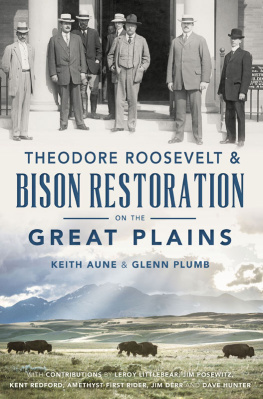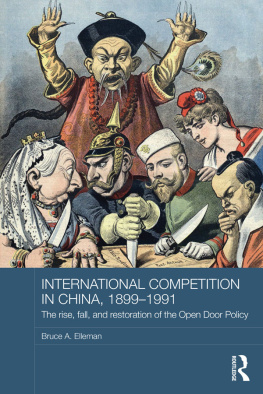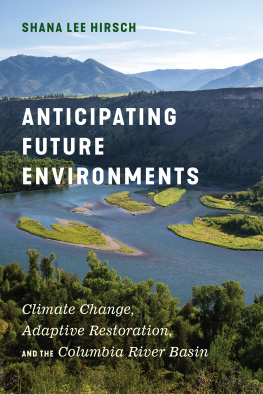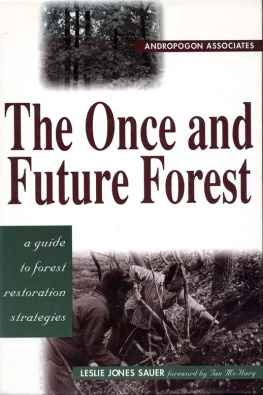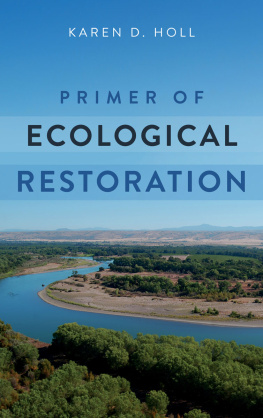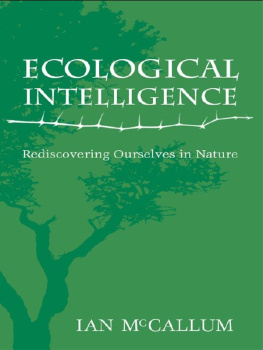Laura J. Martin - Wild by Design: The Rise of Ecological Restoration : The Rise of Ecological Restoration
Here you can read online Laura J. Martin - Wild by Design: The Rise of Ecological Restoration : The Rise of Ecological Restoration full text of the book (entire story) in english for free. Download pdf and epub, get meaning, cover and reviews about this ebook. year: 2022, publisher: HarvardUP, genre: Politics. Description of the work, (preface) as well as reviews are available. Best literature library LitArk.com created for fans of good reading and offers a wide selection of genres:
Romance novel
Science fiction
Adventure
Detective
Science
History
Home and family
Prose
Art
Politics
Computer
Non-fiction
Religion
Business
Children
Humor
Choose a favorite category and find really read worthwhile books. Enjoy immersion in the world of imagination, feel the emotions of the characters or learn something new for yourself, make an fascinating discovery.

- Book:Wild by Design: The Rise of Ecological Restoration : The Rise of Ecological Restoration
- Author:
- Publisher:HarvardUP
- Genre:
- Year:2022
- Rating:5 / 5
- Favourites:Add to favourites
- Your mark:
- 100
- 1
- 2
- 3
- 4
- 5
Wild by Design: The Rise of Ecological Restoration : The Rise of Ecological Restoration: summary, description and annotation
We offer to read an annotation, description, summary or preface (depends on what the author of the book "Wild by Design: The Rise of Ecological Restoration : The Rise of Ecological Restoration" wrote himself). If you haven't found the necessary information about the book — write in the comments, we will try to find it.
Laura J. Martin: author's other books
Who wrote Wild by Design: The Rise of Ecological Restoration : The Rise of Ecological Restoration? Find out the surname, the name of the author of the book and a list of all author's works by series.
Wild by Design: The Rise of Ecological Restoration : The Rise of Ecological Restoration — read online for free the complete book (whole text) full work
Below is the text of the book, divided by pages. System saving the place of the last page read, allows you to conveniently read the book "Wild by Design: The Rise of Ecological Restoration : The Rise of Ecological Restoration" online for free, without having to search again every time where you left off. Put a bookmark, and you can go to the page where you finished reading at any time.
Font size:
Interval:
Bookmark:

 THE RISE OF
THE RISE OF  ECOLOGICAL RESTORATION
ECOLOGICAL RESTORATION
LAURA J. MARTIN

CAMBRIDGE, MASSACHUSETTS
LONDON, ENGLAND
2022
Copyright 2022 by the President and Fellows of Harvard College
ALL RIGHTS RESERVED
Jacket photograph: Cavan Images
Jacket design: Lisa Roberts
978-0-674-97942-0 (hardcover)
978-0-674-27583-6 (EPUB)
978-0-674-27582-9 (PDF)
The Library of Congress has cataloged the printed edition as follows:
Names: Martin, Laura J., 1984 author.
Title: Wild by design : the rise of ecological restoration / Laura J. Martin.
Description: Cambridge, Massachusetts : Harvard University Press, 2022. | Includes bibliographical references and index.
Identifiers: LCCN 2021041664
Subjects: LCSH: Restoration ecologyUnited StatesHistory20th century. | Restoration ecologyUnited StatesHistory21st century. | NatureEffect of human beings onUnited StatesHistory20th century. | NatureEffect of human beings onUnited StatesHistory21st century. | Environmental responsibilityUnited StatesHistory20th century. | Environmental responsibilityUnited StatesHistory21st century.
Classification: LCC QH104 .M38 2022 | DDC 508.73dc23
LC record available at https://lccn.loc.gov/2021041664
I n 1982, George Archibald described to a rapt audience of the Johnny Carson Show the years he had spent mating with an endangered whooping crane. His relationship with the species had begun in graduate school, when he studied crane mating behavior, keeping detailed notes on the dramatic calls and intricate dances of these highly social birds. His relationship with this particular crane, a female named Tex, had begun in 1975, when biologists from the Patuxent Wildlife Research Center in Maryland sent Tex to Baraboo, Wisconsin, where Archibald had co-founded the International Crane Foundation. It was a last-ditch effort to get Tex to reproduce.
When Tex arrived in Wisconsin, whooping cranes were in dire straits. Whooping crane territory had once extended from the Arctic to central Mexico and from Utah to New Jersey, but hunting and widespread draining of wetlands in the early twentieth century had caused whooper numbers to plummet. By 1937, only two perilously small populations remained: a stationary group of fifteen cranes in southwestern Louisiana and a flock of about twenty that migrated between coastal Texas and northern Canada. Decades of campaigns by environmental groups followed, and Congress eventually allocated money to the U.S. Fish and Wildlife Service in 1965 to establish a captive breeding program for whooping cranes at Patuxent. So began the Endangered Species Research Program, the first federal effort to propagate and restore an endangered species.
The problem was that no one knew how to get whooping cranes to breed in captivity. Tex was only the second adult whooping crane to live at Patuxent, and for a number of years, Fish and Wildlife biologists tried and failed to get her to lay a fertile egg. It can take months for two cranes to bond with each other through elaborate ritual dancing, and the male crane at Patuxent, Canus, had a broken wing. In addition, crane chicks imprint on any moving object in their early environment. Tex, the biologists speculated, had imprinted on humans, the first organisms she had met as a chick at the San Antonio Zoo. Other cranes just did not excite her. When the Patuxent biologists sent Tex to Wisconsin, they hoped Archibald would figure out a way to get her to lay a fertile egg through artificial insemination.
Archibald spent several years acting as a male crane with Tex, walking, calling, and dancing in the hopes of shifting her into reproductive condition. In the first year of Archibalds courtship, Tex laid a single unfertilized egg. This was progress, but Tex didnt produce a fertilized egg until Archibald made an all-out effort in the spring of 1982. He and Tex took turns bowing, jumping, and tossing small sticks in the air. They slept in the same space, a shed subdivided by chicken wire into an office for Archibald and a shelter for Tex. From March through May, Patuxent biologists sent fresh whooping crane semen from Patuxent to Baraboo twice weekly, and in late May, Tex finally laid a fertilized egg. Members of a crane pair alternate incubation, so Archibald took his turn every few hours, shuffling his sleeping bag over to the nest when Tex left to forage. I was so excited!, Archibald recounted; I felt like a father.
Archibalds success with Tex was evidence that intensive human intervention might pull a wild species back from the brink of extinction. Encouraged, biologists at Patuxent brought more adults and eggs into captivity from the two tiny remaining wild flocks. They developed egg incubators and experimented with nutritional formulas. Soon they were tending more eggs and chicks than their adult cranes could care for, and so staff and volunteers stepped in to help raise the chicks. To prevent the chicks from imprinting on humans, the caregivers followed a strict protocol. They donned crane costumes, guided the birds with crane-shaped hand-puppets, and never spoke around them. Costumed technicians taught the chicks how to find food and how to explore their penned surroundings. By 1995, biologists were caring for a flock of seventy-two captive whooping cranes at Patuxent and a flock of 39 at the International Crane Foundation.
The goal of whooping crane restoration, however, was not just to create more individuals but to restore wild populations, and introducing captive-bred birds to the wild, it turned out, was just as difficult as breeding them. In May 1989, a female captive-reared whooping crane from Patuxent was released into Grays Lake National Wildlife Refuge in southeastern Idaho. She interacted with other cranes, but it seemed she was unable to fly long distances or to follow them as they migrated, and she disappeared before scientists could recapture her. Into the 1990s, biologists continued to attempt carefully controlled and monitored releases of captive-reared whoopers into sites in the Rocky Mountains and central Florida. While the introduced Rocky Mountain population failed, the Florida population thrivedbut it did not migrate. The trouble was that wild cranes learn their migration route from the previous generation: chicks follow their parents to wintering grounds. Figuring out how to teach captive-bred whooping cranes to migrate was going to take some ingenuity.
Beginning in 2001, the Whooping Crane Recovery Team, a collaboration between the U.S. Fish and Wildlife Service and the Canadian Wildlife Service, attempted to establish a new migratory population that would breed in central Wisconsin and winter in central Florida. Chicks reared at Patuxent were brought to Wisconsins Necedah National Wildlife Refuge in early summer and were taught the migration path by costumed human pilots in ultralight aircraft. Seven birds made it to Florida on the first run, of which five returned to Wisconsin the following spring. The project, dubbed Operation Migration, was enormously popular, an uplifting story for the nation that was struggling with the aftermath of the 911 attack, as one reporter put it, a story that portrayed the aircraft as a tool of restoration rather than of terror.
Next pageFont size:
Interval:
Bookmark:
Similar books «Wild by Design: The Rise of Ecological Restoration : The Rise of Ecological Restoration»
Look at similar books to Wild by Design: The Rise of Ecological Restoration : The Rise of Ecological Restoration. We have selected literature similar in name and meaning in the hope of providing readers with more options to find new, interesting, not yet read works.
Discussion, reviews of the book Wild by Design: The Rise of Ecological Restoration : The Rise of Ecological Restoration and just readers' own opinions. Leave your comments, write what you think about the work, its meaning or the main characters. Specify what exactly you liked and what you didn't like, and why you think so.



